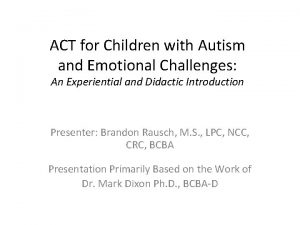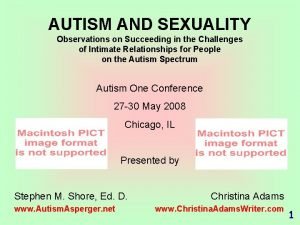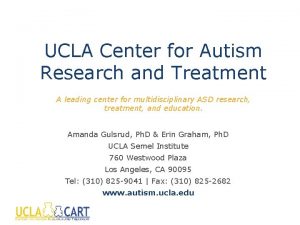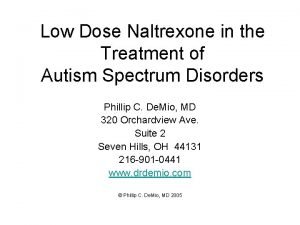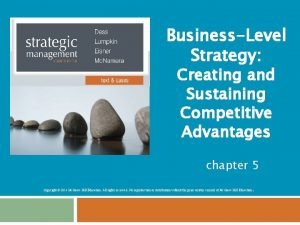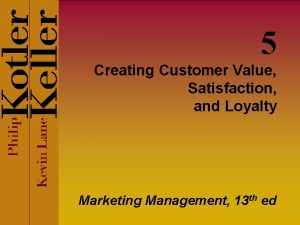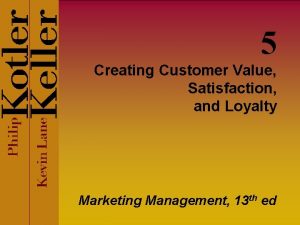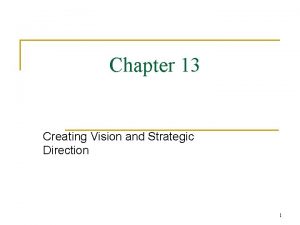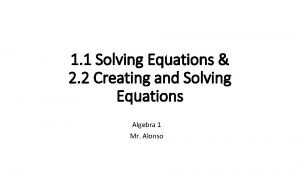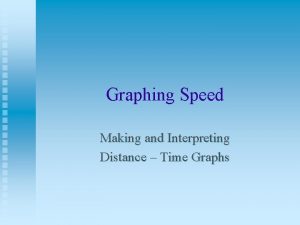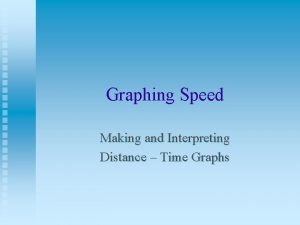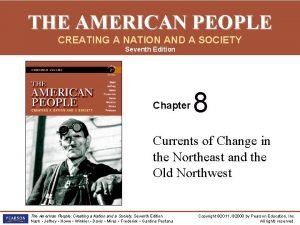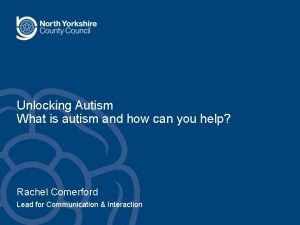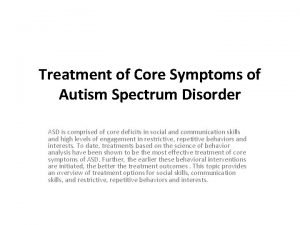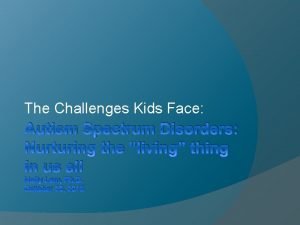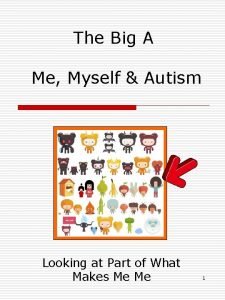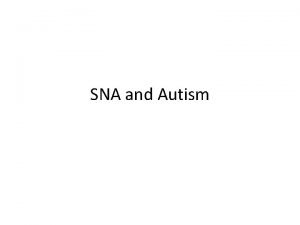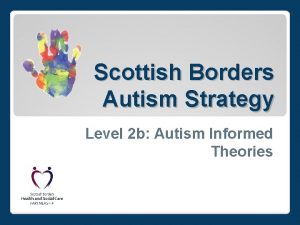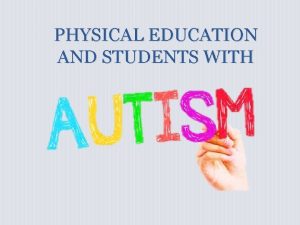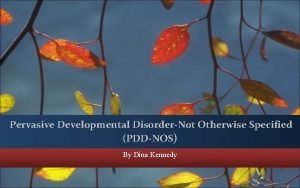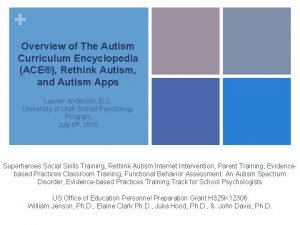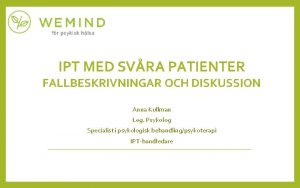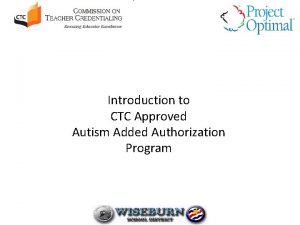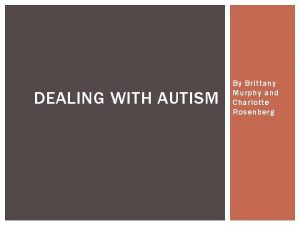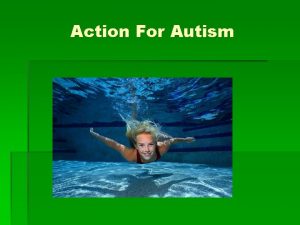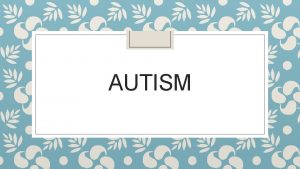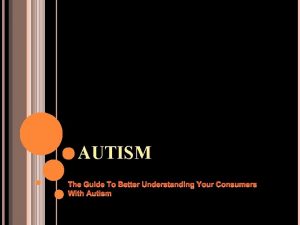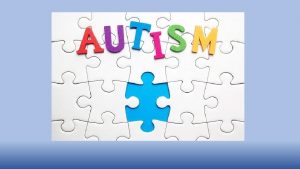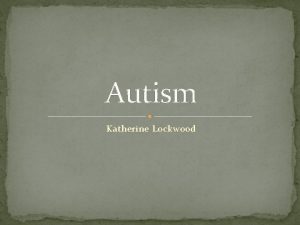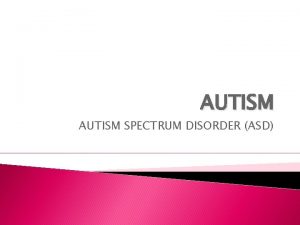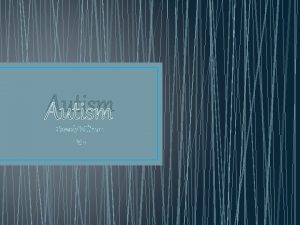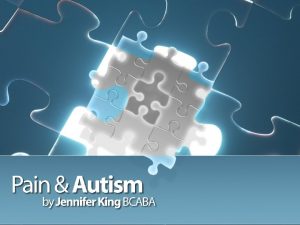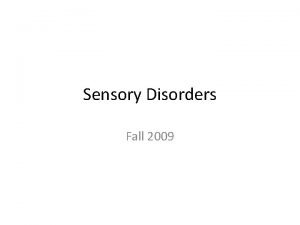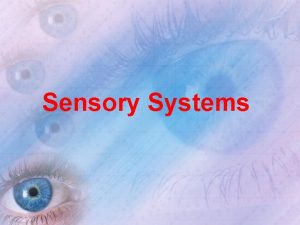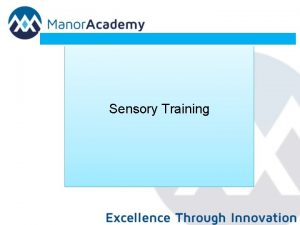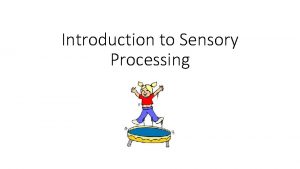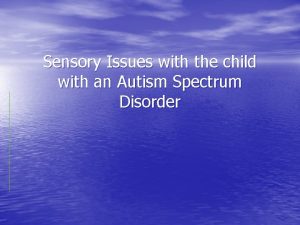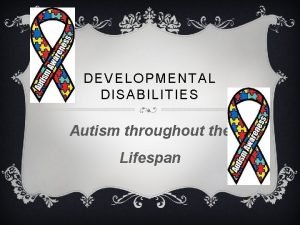Autism and Sensory Issues Creating a Sensory Plan








































- Slides: 40

Autism and Sensory Issues: Creating a Sensory Plan DIARMUID HEFFERNAN

Who Am I -Qualified Youth & Community Worker, Diploma in Community Development, Degree in Social Science, Masters in Social Policy, Post Grad Cert in Teaching and Learning in Higher Ed. -Lecturer in Autism Studies - Part of the team that developed Autism Studies at UCC -Specialize in working with people on the spectrum (and their families) individually and in groups -Ten years experience of working with people with ASD

Books Living with Asperger Syndrome and Autism in Ireland (Stuart Neilson, Diarmuid Heffernan) Sensory Issues for Adults with Autism Spectrum Disorders (Diarmuid Heffernan)

What is ASC Is a partnership between Kirsten Hurley and I, includes people with ASD as peer mentors Its focus includes: Positive social interactions People with ASD can and should learn from each other

Structure of this Presentation Intro Sensory issues and anxiety Autism and Design Environments and contexts Plan Framework

Two ways of Approaching Sensory Issues Strategies for coping with the sensory environment (the individual adapts) Strategies for changing the sensory environment (adapting the environment) In this presentation I will look at both but this question should be central to the creation of a plan – can the environment be adapted or can the person adapt to their environment?

Why A Plan? To create a framework for engaging with potentially problematic environments and contexts To provide reassurance – dealing with the expected

A Collaboration! The plan should be created as a collaboration with the client and family/parents/partners A person-centred approach should be followed, tailored to each individuals needs

What should be included The persons history and experiences should be discussed in the first instance i. e. school experiences, college, work The importance of design Contexts, school, college, work, relationships Measures to assess relative success of strategies Each person will experience different sensory inputs both hypo and hyper depending on environment etc The relationship between anxiety and sensory issues, commensurate strategies

Anxiety and Sensory Issues

Interoception and Alexithymia Interoception is our ability to perceive the internal state of ones own body, e. g. hunger, pain, itch, body temp, sexual arousal Impaired interoception is an impairment of the receptors relaying these signals from body to brain This may also impair the persons ability to recognise emotions due for example to inability to recognise symptoms of stress (racing heart, sweating etc),

CONTD Emotional signals (e. g. mood) not perceived and not integrated into our decision making (Alexithymia), Difficulties having an inherent core sense of the world (gut feeling) can lead to creation of rules which are abided by to the detriment of the person (black and white thinking) Strategies for dealing with interoceptive difficulties involve OT input. Generally involving Vestibular alerting or calming exercises

Sensory Issues and Anxiety Data obtained from self- and informant-report instruments suggest that up to 50% of young people with ASD may score above normative levels for social anxiety An intolerance of uncertainty, or hypo- and hyper-sensory sensitivities, have been found to be associated with anxiety symptoms (Boulter, Freeston, South, and Rodgers, 2014; Wigham, Rodgers, South, Mc. Conachie, & Freeston, 2015) and these may encourage avoidance of social situations, e. g. because these seem unpredictable or overly stimulating

Robertson et al Study on Sensory Issues and Anxiety Negative experiences with sensory stimuli could lead to avoidance, which is relevant when considering the role that anxiety could play. (Robertson et al). Participants in the study routinely experienced difficulties with sensory stimuli, often resulting in strong physiological (e. g. , experiencing pain) and emotional reactions (e. g. , experiencing a surge of hostility toward others). Finally, it was also found that sensory stimuli could have a calming effect.

Sources of Anxiety Sound and light sensitivities Meeting deadlines Lack of sleep Making eye contact Crowds Ambiguous/open questions Uncertainty/making decisions Losing things Delays (e. g. , transport) Understanding social etiquette Anticipation and disappointment Bullying and gossip Unexpected or sudden change Managing finances Health concerns Explaining diagnosis Public speaking Life transition (e. g. , leaving school) Communicating with others Obsessive thoughts/behaviour Perceived injustice to self or others Authority (e. g. , police, security) News reports and other media

What to do? Accurate identification of possible anxiety-provoking situations, signs, and symptoms, as well as potential predisposing and preventive factors, will be pertinent to the development and implementation of effective coping strategies for this population (Bellini, 2006; Reaven et al. , 2009).

Strategies for Coping with Anxiety Listening to music Sleep Heart rate monitors Mood monitor (visual chart) Singing Exercise (walk, swim, run) Allowing extra travel time Journaling Watching movies or TV Looking at pictures Developing multiple interests Talking with trusted person Online learning Self-talk Alternative therapies Deep breathing and meditation Study social skills resources Online social networking Humor Computer games

Autism and Design

Why Design? To create a physical environment that reflects the sensory needs of people with ASD Examples include sensory rooms at airports, autism friendly shopping, cinema etc It can also include the persons home space or work space if possible It creates continuity and certainty, aids transitions

Design Guidelines Where to live? E. g. Safe area, good quality housing, close to amenities, far from unwanted noises Layout of the abode, own space, where is bedroom in relation to other rooms, practicalities Visual cues, to create a ‘map’ of markers from one space to another, what is the function of each space

Design Contd Ventilation, getting enough air into the space Lighting, types of lightbulb – fluorescent? , adjustable lighting Acoustics, noises associated with each part of the house to be considered, need to be conducive to sensory needs Appliances, that can be set by timer, noise of appliances (Adapted from Steele and Ahrentzen, 2009)

Environments and Contexts: Things to Consider

A Starting Point Anticipate and pre-empt potential sensory issues through preparation Visit a new school, college, workplace Practice the journey at the appropriate time Anticipate the sensory inputs and how they can be ameliorated

Home Dividing up home spaces Dividing by time Dividing up shared spaces A better sensory environment (where room is located in the house, noises, smells etc. ) Transitions between rooms Colour coding

School Pre-emptive work, knowledge of school environments especially public spaces of school This plan should be a collaboration with the school/teachers, parents Sensory breaks Pre-emptive sensory breaks Placement in classroom Teachers awareness School environment (lights, sounds etc. )

College Pre-emptive knowledge of college How to get to college and implications of this (e. g. public transport) Lecturer awareness Sensory breaks Public spaces (e. g. library) Disclosure

Work Picking the right work environment Job interview Disclosure How to get to work (e. g. public transport) Sensory breaks Divided work space Headphones

Relationships Dating-meeting in the right space Sex, touch, taste, smell, sound Co-habiting (creating the right sensory environment) Compromise Children

Plan: Framework/Guidelines

Guidelines for a Sensory Plan History/experiences (Building a Profile) What has the persons experience been with public and private spaces in the past, for example school, college, work, private spaces, shared spaces, relationships, memories associated with spaces Anxiety and Sensory Issues Sources of anxiety (internal) sights, sounds, smells, taste, Sources of anxiety (external) crowds, classrooms, lecture halls, workplaces, public transport Transitions Design What can be done to aid the sensory needs of the individual in different spaces, e. g. school environment, college, work, shared spaces

Guidelines for a Sensory Plan (Contd) Contexts School : What are the sensory challenges of school that the person experiences, classrooms, corridors, break times, public transport/travel What strategies can the person employ in schools in order to manage sensory challenges College: What are the sensory challenges of college, lecture halls, libraries, corridors, labs, restaurants/lunch halls, social environments, public transport/travel Work: individual work spaces, sensory issues associated with the type of work, radios, canteens, corridors, social spaces, public transport/travel

Contd Relationships Shared spaces and the sensory challenges contained within Intimacy/sex and the inherent sensory challenges associated Children, giving birth, shared spaces with children, noises, smells, tastes, public spaces with children, children’s parties, playgrounds, toys Review Look back over what has worked and what hasn’t, tailor the strategies as necessary

Limits of a Plan Each person will experience spaces differently depending on how they are feeling/level of anxiety Disclosure It is not always possible to create a good sensory space- e. g. workplaces, etc. It will not necessarily change others awareness

Reference List Ahrentzen, S. Steele, K. (2009) ‘Advancing full spectrum housing’ Arizona Board of Regents, http: //stardust. asu. edu/project-archive/advancing-full-spectrum-housing Bauminger N, Shulman C, Agam G. (2004) J Dev Phys Disability; 16(2): 193– 214 The link between perceptions of self and of social relationships in high-functioning children with autism. Carrington, S. , Templeton, E. , & Papinczak, T. (2003). Autism and Other Developmental Disabilities, 18(4), 211– 218 Adolescents with Asperger syndrome and perceptions of friendship. Focus on. Compas BE, Connor-Smith J, Jaser SS. (2004) J Clin Child Adolesc; 33(1): 21– 31 Temperament, stress reactivity, and coping: implications for depression in childhood and adolescence. . T. Rene Jamison, Jessica Schuttler, Molecular Autism (2015) 6: 53 Examining social competence, self-perception, quality of life, and internalizing and externalizing symptoms in adolescent females with and without autism spectrum disorder: a quantitative design including between-groups and correlational Analyses

Rhind et al (2014) Molecular Autism, 5: 56 An examination of autism spectrum traits in adolescents with anorexia nervosa and their parents Baron-Cohen et al. (2013) Molecular Autism, 4: 24 Do girls with anorexia nervosa have elevatedautistic traits? Halladay et al. (2015) Molecular Autism 6: 36 Sex and gender differences in autism spectrum disorder: summarizing evidence gaps and identifying emerging areas of priority

Schauder, K. B. , Mash, L. E. , Bryant, L. K. , & Cascio, C. J. (2015). Journal of Experimental Child Psychology 131, Interoceptive ability and body awareness in autism spectrum disorder. Tavassoli, T. (2017), Developmental Cognitive Neuroscience Sensory reactivity, empathizing and systemizing in autism spectrum conditions and sensory processing disorder Cage, et al, (2016) ‘I am who I am’ Research in Autism Spectrum Disorders Reputation concerns in adolescents on the autism spectrum

Mayes, S, (2013) Research in Autism Spectrum Disorders 7, 109– 119, Suicide ideation and attempts in children with autism Shumer et al (2016) LGBT health, 23. 1% of patients presenting with gender dysphoria had possible, likely, or very likely AS De Vries et al, (2010) J. Autism Dev Disorders, No 40, pp 930 -936 Strang et al (2014) Archives of Sexual Behaviour, No 43, pp 1525 -1533

Robertson et al, (2016) Focus on Autism and Other Developmental Disabilities � 1– 11, The Relationship Between Self-Reported Sensory Experiences and Autistic Traits in the General Population: A Mixed Methods Analysis Trembath et al, (2012) Focus on Autism and Other Developmental Disabilities, 27(4) 213– 224, The Experience of Anxiety in Young Adults With Autism Spectrum Disorders

Reaven, J. , Blakeley-Smith, A. , Nichols, S. , Dasari, M. , Flanigan, E. , & Hepburn, S. (2009). Focus on Autism and Other Developmental Disabilities, 24, 27– 37 Cognitive-behavioural group treatment for anxiety symptoms in children with high-functioning autism spectrum disorders: A pilot study. Bellini, S. (2006). Focus on Autism and Other Developmental Disabilities, 21, 138– 145 The development of social anxiety in adolescents with autism spectrum disorders.

Wigham, et al (2015)Journal of Autism and Developmental Disorders 45: 943– 952, The Interplay Between Sensory Processing Abnormalities, Intolerance of Uncertainty, Anxiety and Restricted and Repetitive Behaviours in Autism Spectrum Disorder Boulter, C. , Freeston, M. , South, M. , & Rodgers, J. (2013). Journal of Autism and Developmental Disorders Intolerance of uncertainty as a framework for understanding anxiety in children and adolescents with autism spectrum disorders.
 Creating and interpreting graphs and tables
Creating and interpreting graphs and tables Puberty and autism spectrum disorders
Puberty and autism spectrum disorders Self as context
Self as context Chess autism
Chess autism Autism and relationships
Autism and relationships Glyphosate and autism
Glyphosate and autism Ucla autism center
Ucla autism center Naltrexone and autism
Naltrexone and autism Creating production possibilities schedules and curves
Creating production possibilities schedules and curves Marketing creating customer value and engagement
Marketing creating customer value and engagement Creating and sustaining competitive advantage
Creating and sustaining competitive advantage How to create customer value satisfaction and loyalty
How to create customer value satisfaction and loyalty Creating customer value satisfaction and loyalty
Creating customer value satisfaction and loyalty Inner critic and inner defender
Inner critic and inner defender Creating and starting the venture
Creating and starting the venture Creating vision and strategic direction
Creating vision and strategic direction 2-2 creating and solving equations
2-2 creating and solving equations Creating and capturing customer value
Creating and capturing customer value Marketing concept
Marketing concept Creating customer value satisfaction and loyalty
Creating customer value satisfaction and loyalty Excel module 1: creating a worksheet and a chart
Excel module 1: creating a worksheet and a chart An expanded model of the marketing process
An expanded model of the marketing process Creating and interpreting distance time graph
Creating and interpreting distance time graph Creating and interpreting distance time graph
Creating and interpreting distance time graph The american people creating a nation and a society
The american people creating a nation and a society Creating value and capturing value
Creating value and capturing value The autism iceberg
The autism iceberg Core symptoms of autism
Core symptoms of autism Many faces of autism
Many faces of autism Autism range severity
Autism range severity The big a autism
The big a autism What is a sna
What is a sna Central coherence theory autism
Central coherence theory autism Physical education adaptations for autism
Physical education adaptations for autism What is pdd-nos
What is pdd-nos Ace for autism
Ace for autism Familia i
Familia i Fallbeskrivning autism
Fallbeskrivning autism Autism authorization california online
Autism authorization california online Does sheldon cooper have autism
Does sheldon cooper have autism Macey hensley autism
Macey hensley autism


